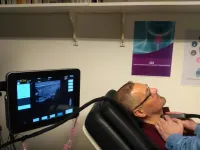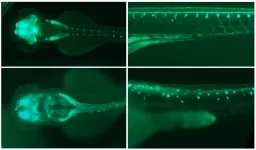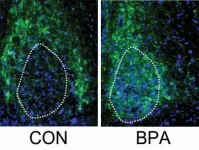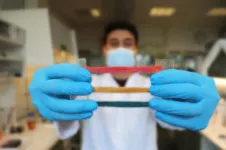(Press-News.org) Thyroid nodules are a common pathology having a prevalence of 19-76% when screened with ultrasound, with higher frequencies in women. Current medical methods used to assess the malignancy of a nodule consist in performing an ultrasound, followed by a Doppler ultrasound, and then a biopsy. However, unfortunately, these methods present both low specificity and low sensitivity. This insufficient effectiveness in accurately being able to diagnose thyroid tumors leads to many unclear or unnoticed cases as well as many others that undergo unnecessary surgeries (false positives) and increase the cost of medical healthcare, not to mention the reduction of quality of life of patients.
The EU-funded project Laser and Ultrasound Co-analyzer for Thyroid Nodules (LUCA) started in 2016 and over its 5 years of duration, it worked on the development of a new low-cost near-infrared optical device combined with ultrasound that searched to provide doctors with enhanced information required to provide better and more specific results in thyroid nodule screening. The goal of such device was mainly to enable a better diagnosis of this type of cancer because so far, there was no accurate way of determining whether a thyroid tumor as benign or malignant.
The LUCA device is a multi-modal platform combining near infrared light, time resolved spectroscopy (TRS), diffuse correlation spectroscopy (DCS), and ultrasound in one single device.
Clinical testing with LUCA
The study recently published in Biomedical Optics Express and authored by members of the consortium reports on several study cases and clinical tests conducted to validate the accuracy and high quality of measurements achieved by the LUCA device.
As a first step, the TRS and DCS modules were tested independently using phantom1 tests to validate the performance of both under the different European medical standardization protocols. For the former module, a set of solid phantoms with different absorptions and scatterings was used to assess the capability of the device to detect absorption and scattering changes, while for the latter, a set of liquid phantoms with different viscosities was used to assess the capability of the device of measuring the movement of the particles in suspension in the liquid phantom. The tests performed did prove to be successful, validating the outstanding performances of both modules.
Then, as a second step, the team of experts performed a series of in vivo characterization tests on a model healthy patient. By scanning the thyroid gland, simultaneously with ultrasound imaging, TRS and DCS, several times a day in different days and different weeks, they were to determine the precision of the LUCA device in measuring the hemodynamic parameters related to the thyroid gland.
Recently, the device has been moved into the clinical environment and tested on 18 healthy volunteers and 47 patients were diagnosed with thyroid nodules and were scheduled for thyroidectomy. The LUCA device showed potential for identifying the group of nodules as benign or malignant, which were stipulated as unclear cases with the classical ultrasound screening technique. By analyzing the metabolic rate of oxygen consumption and total hemoglobin concentration, the device was able to classify thirteen benign and four malignant nodules with a sensitivity of 100% and specificity of 77%.
Dr. Mireia Mora from the August Pi i Sunyer Biomedical Research Institute (IDIBAPS) in Barcelona, Spain, which is responsible for the clinical application of the tool, under the direction of Prof. Ramon Gomis, highlights the fact that "The need to improve the current standards of thyroid cancer diagnosis has driven us to participate in this multidisciplinary project. We have taken the first steps in preclinical testing, but are sure that with this technology we will be able to avoid unnecessary surgeries and thus improve the quality of life of our patients".
Dr. Turgut Durduran, coordinator of the LUCA project, group leader at ICFO of the Medical Optics research group, commented that "this project has allowed us to develop a unique optical-ultrasound platform that we are confident that will find a use in the clinical thyroid cancer screening". Recent advances of diffuse optical techniques have shown that not only these techniques have a tremendous potential in this field, but other fields as well, such as breast, head and neck cancer, abdominal cancer screening and therapy monitoring, cerebrovascular accidents (ictus) or even for COVID19, to name a few. Durduran finally remarks, "We have learnt a lot and are anxious to continue working in this line of research because we believe that this technique could substantially improve the quality of measurements, narrow down diagnosis and helps asses in possible treatments of patients".
Diffuse optics to improve medical diagnosis and treatment
Near infrared diffuse optical spectroscopy is an optical method that provides significant complementary information to other medical techniques used for imaging, such as ultrasounds. The LUCA device incorporates two different diffuse optical spectroscopy technologies (TRS and DCS) to improve the screening of thyroid nodules for cancer. These techniques have made it a completely novel device, because it is non-invasive and safe to use, portable, low cost, it probes deep enough into the tissue (>1cm deep) to give substantial information about the surrounding tissue, in this case the thyroid, and it provides a real-time monitoring evaluation together with the ultrasound counterpart.
The TRS and DCS modules consist of custom-made components, such as laser heads and off-the-shelf-electronics for detectors and acquisition electronics, which makes them cheaper than any other commercially available TRS and DCS devices.
Despite being low cost, the custom developed components enhance performance features allowing the LUCA device to obtain high quality measurements of the tissue's hemodynamics (blood flow and oxygen at the microvascular level), chemical constitution (water and lipids concentration) as well as anatomy.
INFORMATION:
Reference: The LUCA device: a multi-modal platform combining diffuse optics and ultrasound imaging for thyroid cancer screening, Lorenzo Cortese, Giuseppe Lo Presti, Marta Zanoletti, Gloria Aranda, Mauro Buttafava, Davide Contini, Alberto Dalla Mora, Hamid Dehghani, Laura Di Sieno, Sixte de Fraguier, Felicia A. Hanzu, Mireia Mora Porta, An Nguyen-Dinh, Marco Renna, Bogdan Rosinski, Mattia Squarcia, Alberto Tosi, Udo M. Weigel, Stanislaw Wojtkiewicz, and Turgut Durduran, 2021, Biomedical Optics Express Vol. 12, Issue 6, pp. 3392-3409 (2021) https://doi.org/10.1364/BOE.416561
LINKS OF INTEREST
Link to the paper: https://www.osapublishing.org/boe/fulltext.cfm?uri=boe-12-6-3392&id=451065
Link to the LUCA project video: http://luca-project.eu/news/new-luca-video
Link to the LUCA project: http://www.luca-project.eu/
Link to the research group led by ICREA Prof. at ICFO Turgut Durduran: https://www.icfo.eu/lang/research/groups/groups-details?group_id=29
BACKGROUND
The LUCA project ran from February 1st, 2016 to May 31, 2021 bringing together recognized organisations and industrial partners from all over Europe: ICFO -The Institute for Photonic Sciences, ES (Scientific Coordinator); Politecnico di Milano, IT; August PI i Sunyer Biomedical Research Institute (IDIBAPS), ES; Hemophotonics SL, ES; Vermon SA, FR; IMV Imaging France, FR; University of Birmingham, UK; European Institute for Biomedical Imaging Research, AT.
The LUCA project (http://www.luca-project.eu) receives funding from the European Union's Horizon 2020 research and innovation programme under grant agreement No 688303 and is an initiative of the Photonics Public Private Partnership (http://www.photonics21.org).
DISCLAIMER
This publication reflects only the authors' views and the European Union is not liable for any use that may be made of the information contained therein.
When the Augustinian monk Gregor Mendel crossed white-flowering with purple-flowering pea plants in the mid-19th century, he made an interesting discovery: The offspring were all purple. He therefore called this trait dominant, while the white blossom color was recessive. The reason for this phenomenon: In peas, each gene occurs twice. One version comes from the maternal plant and the other from the paternal plant. If a pea has inherited the gene for purple flower color from one parent, but the gene for white flower color from the other, purple wins. Only when two genes for white flowers come together in the offspring plant is it white.
Humans also have genes that are inherited either dominantly or recessively. However, the case is not so clear for the mutations investigated ...
Using a Fitbit and a spy mic, scientists have discovered new insight into the behaviour of the elusive Canada lynx. A new study by researchers from McGill University, University of Alberta, and Trent University provides a first look at how miniaturized technology can open the door to remote wildlife monitoring.
"Working on one of the boreal forest's top predators, the Canada lynx, we found that two different technologies, accelerometers and audio recording devices, can be used to remotely monitor the hunting behaviour of predators, even documenting the killing of small prey," says lead author Emily Studd, a Postdoctoral Fellow under the supervision of Murray Humphries at McGill University and Stan Boutin at University ...
The University of Ottawa's Positive Energy program released new survey results showing that a large segment of the Canadian public does not trust the courts to settle disputes over energy projects or climate policy. The survey was conducted by Positive Energy's official pollster, Nanos Research.
Canadians were asked: On a scale of 0 to 10, where 0 means do not trust at all and 10 means trust completely, how much do you trust the courts to settle disputes over government decisions on energy projects? They were asked the same question for climate policy. The results are very similar. Only one in three Canadians trust the courts to settle disputes over energy projects or climate policy (answering between 7 and 10: 31% for energy, 30% for ...
Machine learning, when used in climate science builds an actual understanding of the climate system, according to a study published in the journal Chaos by Manuel Santos Gutiérrez and Valerio Lucarini, University of Reading, UK, Mickäel Chekroun, the Weizmann Institute, Israel and Michael Ghil, Ecole Normale Supérieure, Paris, France. This means we can trust machine learning and further its applications in climate science, say the authors. The study is part of the European Horizon 2020 TiPES project on tipping points in the Earth system. TiPES is administered from the University of Copenhagen, Denmark.
Man or ...
Humans are exposed to a bath of chemicals every day. They are in the beds where we sleep, the cars that we drive and the kitchens we use to feed our families. With thousands of chemicals floating around in our environment, exposure to any number is practically unavoidable. Through the work of researchers like Dr. Deborah Kurrasch, PhD, the implications of many of these chemicals are being thoroughly explored.
"Manufacturers follow standards set by regulatory bodies, it's not up to the manufacturers to prove the chemicals in consumer products are safe," says Kurrasch, a researcher in the University of Calgary's Hotchkiss Brain ...
Right-wing voices set out powerful but misleading arguments to justify inaction by the Trump administration during the COVID-19 pandemic, according to a new study of the rhetoric used by high-level government officials and influential commentators in the US during the first half of 2020.
In a study published in the DeGruyter journal Open Anthropological Research, Professor Martha Lincoln of San Francisco State University examined how public officials openly pushed for people to accept widespread illness and death from the virus by adopting a tone that suggested premature death was normal and the scale of death acceptable in the grander ...
RUDN mathematician and his colleagues from China, Egypt, Saudi Arabia, United Kingdom, and Qatar have developed an algorithm allowing the distribution of computing tasks between the IoT devices and the cloud in an optimal way. As a result, the power and time costs are reduced by about three times. The study was published in the Big Data.
With the development of technologies and devices, Internet of Things (IoT) applications require more and more computing power. The amount of data that the IoT devices need to process can be so large that it is reasonable to migrate computing to the cloud. Cloud computing provides flexible data processing and storage capabilities. But Computation offloading, meaning transferring of the resource-intensive processes ...
A DTU research team consisting of Malgorzata Gosia Pierchala, Firoz Babu Kadumundi, and Mehdi Mehrali from #TeamBioEngine headed by Alireza Dolatshahi-Pirouz, have developed a new material - CareGum - that among other things has potential for monitoring motor impairment associated with neurological disorders such as Parkinson's.
A green material with many properties
The CareGum property portfolio is incredibly broad with feats such as skin-like softness, it is stretchable up to 30,000 % and has self-healing capacities reminiscent of that of natural tissues. It is printable, moldable, and electrically conductive. Notably, the electrical conductivity enables the material to respond to external stimuli ...
Oncotarget published "STAT3 induces the expression of GLI1 in chronic lymphocytic leukemia cells" which reported that what induces GLI1 expression in GLI1-unmutated CLL cells is unknown.
Because signal transducer and activator of transcription 3 is constitutively activated in CLL cells and sequence analysis detected putative STAT3-binding sites in the GLI1 gene promoter, the authors hypothesized that STAT3 induces the expression of GLI1.
Western immunoblotting detected GLI1 in CLL cells from 7 of 7 patients, flow cytometry analysis confirmed that CD19 /CD5 CLL cells co-express GLI1 and confocal microscopy showed co-localization of GLI1 and phosphorylated STAT3. Chromatin immunoprecipitation showed ...
A series of autopsies performed in an infectious disease hospital in the Brazilian Amazon reveals that infections by the Histoplasma fungus are a major cause of death in people with HIV. The study, led by Barcelona Institute for Global Health (ISGlobal), an institution supported by "la Caixa" Foundation, in collaboration with a team in Manaus, highlights the need of implementing sensitive methods to detect these infections in Histoplasma-endemic regions.
Histoplasmosis is a lung infection caused by inhalation of spores from a fungus (Histoplasma), and is frequent in some areas of the US, Africa, and Latin America.
In the majority of individuals with a functional immune system, the infection causes mild symptoms. However, in people who are immuno-compromised, such ...








